
Antique Cedar Extension Table with Two Leaves, 153-239cm Long
Antique cedar extension table no winder, 153 cm long plus 2 extension leaves 83 cm, 121 cm wide, 72 cm high
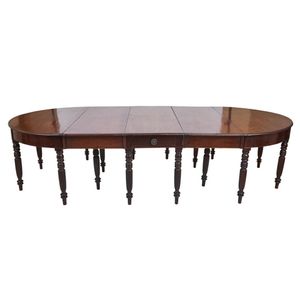
1835 Australian Cedar Dining Table with Provenance from Lady Massy-Greene
A magnificent and early cedar dining table, Australian circa 1835. a sixteen leg drop leaf sectional table with two extension leaves and centre section with drawer at either side with original brass handle; edge stringing on bottom of skirt and running…
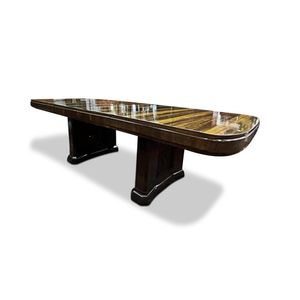
Australian Art Deco Table in Queensland Walnut with Floral Carvings
Rare Australian Art Deco table, in Queensland walnut, the rectangular extension top with two leaves and raised on twin pedestals, finely carved and pierced with flowers and foliage, 82 cm x 259.5 cm x 113.5 cm
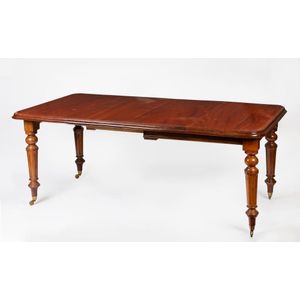
Late Victorian Mahogany Extension Dining Table with Provenance
A late Victorian mahogany extension dining table, 19th century, with two leaves and raised on turned legs with brass casters, the table 74 cm high, 196 cm wide (with leaves), 105 cm deep, Provenance, Drake House, Australian Catholic University (Acu)
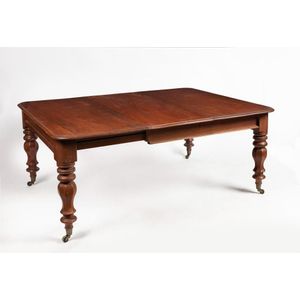
19th Century Cedar Extension Dining Table
A cedar extension dining table, Australian, 19th century, the bullnose rectangular top above a band frieze, raised on turned and faceted legs with toupie feet and brass casters, one leaf, 73 cm high, 173 cm wide (without leaf), 135 cm deep. Provenance:…
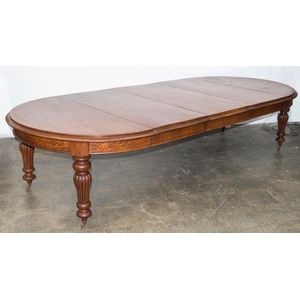
19th Century Cedar Dining Table with Extension Leaves
A fine Colonial Australian cedar three leaf extension D-end dining table, 19th century 74 cm high, 137 cm (extends to 314 cm) wide, 137 cm deep

Victorian Cedar Extension Table with 3 Leaves
Victorian style cedar D end extension table 242 cm long including 3 extension leaves 97 cm, 122 cm wide, 76 cm high.

Victorian Cedar Oval Extension Table
A Victorian cedar oval extension table. Second half 19th century, the D-ended extension table with thumbnail and bullnose edge top, plain skirt, raised on baluster legs terminating in toupie feet with brass caps and porcelain casters, with three extension…

Colonial Cedar Dining Table with Extension Leaves and Brass Castors
Australian Colonial cedar dining table, 'D' ends with two extension leaves on turned legs terminating into brass castors

Victorian Cedar Extension Table & Six Chairs
A Victorian cedar extension table with six chairs, mid 19th century, with three leaves, the bullnose and thumbnail edged circular table with a deep skirt, raised on turned baluster legs with acanthus carved cups and brass casters, and a set of balloon…

19th Century Australian Cedar Extension Dining Table
An Australian cedar two leaf 'D' end extension dining table, 19th century, 77 cm high, 135 cm diameter (extends to 228 cm)

Victorian Cedar Extension Table with D-End Design
Victorian cedar D end extension table 176 cm long, including 1 extension leaf 58.5 cm.119 cm wide, 72.5 cm high

Antique cedar dining table by J.G. Olding, 1880
A rare Australian Colonial cedar draw-leaf extension dining table, by makers J.G. Olding of Pirie St Adelaide, 4th June 1880

Australian Cedar Georgian Dining Set with Six Chairs
An Australian reproduction hand-made Georgian style dining setting comprising six chairs and extension dining table, Australian cedar, circa 1964, the table 77 cm high, 52 cm wide (extends to 156 cm), 97 cm deep

Antique Australian Extension Table by August Altmann
Early Australian pine and cedar extension table by makers 'August Altmann' . Provenance: From the Estate of Pastor Dost, Rosedale. It was constructed by A. Altmann of Lobethal in about 1860, paper label to interior of drawer

Victorian Cedar Dining Table with Two Leaves and Winder
Victorian cedar extension dining table with two leaves, winder and four leg supports. 193 cm long, 122 cm wide and 76 cm tall.

1920s Australian Blackwood Dining Suite with 8 Chairs
Australian dining suite circa 1920s fiddle back blackwood nine piece, extension table with rectangular top, and large turned legs, & eight matching chairs, height 76 cm, length 241 cm, depth 122 cm

Victorian Cedar Dining Set with Eight Chairs
A Victorian cedar two leaf extension dining table, eight chairs, 1850s, 6 chairs by S.Groves, merchant stamp of Miles Kington & Co. To one the oval table with bull nose edging, a deep skirt and raised on ball and trumpet shaped legs with cabochons and…
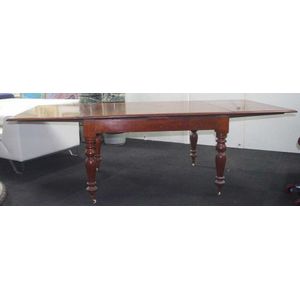
Cedar Extension Table: 238cm long, 108cm wide, 75cm high
Cedar drawer leaf extension table 238 cm long extended, 127 cm long not extended, 108 cm wide, 75 cm high
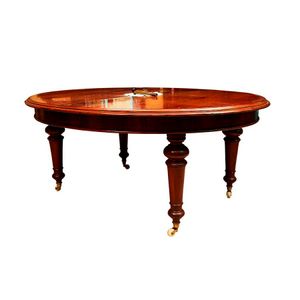
Colonial Cedar Extension Dining Table, c. 1860
Australian Colonial cedar extension dining table, c. 1860, the oval top with moulded edge, above four turned legs terminating in brass and porcelain casters, with two cedar extension leaves, and a reproduction brass and cedar winding handle, height 76 cm,…

1880 Australian Cedar Extension Table with Crank Handle
Australian cedar extension table circa 1880, length 259 (extended) width 138, height 73 cm, includes Crank handle, one leaf has been stripped

Victorian Cedar Table & William IV Mahogany Chairs Set
Dining suite seven piece, Victorian cedar extension table, with turned legs, & six William IV mahogany chairs

19th Century Australian Cedar Dining Table with Extensions
A Colonial eight legged extension dining table, Australian cedar, 19th century 76 cm high, 115 cm wide (extends to 208 cm), 126 cm deep

Victorian Cedar Extension Dining Table with Two Leaves
A late Victorian cedar extension dining table, winding handle, plus two extension leaves (59 cm total) 78 x 142 x 108 cm [Closed]

Antique Tasmanian Cedar Table, 1825
A rare Tasmanian table, cedar, circa 1825, formerly one end of a sectional dining table, possibly the work of convict maker Penman, (see Fahy, Craig and Robertson, plate 121), 72 cm high, 120 cm wide, 75 cm deep

William IV Cedar Extension Table with Carved Baluster Legs
A William IV cedar extension table, circa 1830s, with three leaves and winder, the table with rounded corners having a thick top above an extended bullnose edge, a deep skirt and raised on relief carved knopped and centurion skirt style baluster legs and…

Antique Colonial Cedar Banquet Table with Extra Leaves
A 19th century Australian Colonial cedar banquet table with D ends and three extra leaves on turned carved tapering legs, 74 cm high, 137 cm wide, 343 cm long extended

Victorian Cedar Extension Table - 182cm Long
Victorian cedar extension table, 182 cm long (including 58.5 cm extension), 103 cm wide, 76 cm high

Colonial Cedar Extension Dining Table with Turned Legs
Australian Colonial cedar 'D' end extension dining table with two leaves and turned legs

Red Cedar Colonial Extension Dining Table with Octagonal Legs
A Colonial extension dining table with 2 leaves, Australian red cedar with shaped octagonal legs, mid 19th century, 74 cm high, 119 cm diameter (when closed), extends to 241 cm

Australian Cedar Extension Dining Table, Circa 1845
A fine extension dining table with four extension leaves, Australian cedar, circa 1845, 74 cm high, 134 cm extends to 353 cm, 142 cm wide

1860 Cedar Extension Dining Table with 8 Legs and Leaves
A cedar extension dining table with 8 legs and 2 leaves, circa 1860, 75 cm high, 117 cm wide (256 cm extended), 116 cm deep

Antique Cedar Extension Dining Table - Seats 10
Extension dining table. Mid 19th century Australian cedar two leaves ten seater 245 x 125 cm
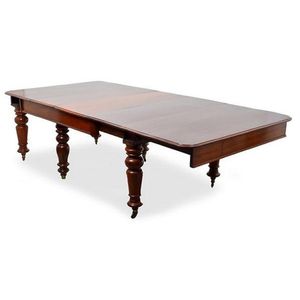
19th Century Australian Cedar Extension Dining Table
A large fine quality 19th century Australian cedar extension dining table, rounded rectangular, above turned supports on brass castors, seven leaves, 410 x 75.5 x 120 cm
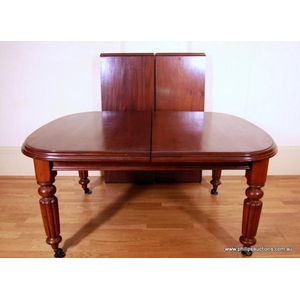
Victorian Cedar Dining Table with Extensions
A Victorian cedar extension dining table. second half 19th century, with two extension leaves, in warm tones, the rectangular table with rounded ends, having a bullnose and thumb nail edged top above a shallow skirt and ball and ribbed tapering legs…

Rare Antique Cedar Banquet Dining Table with 8 Extensions
Impressive rare size antique cedar banquet dining table, comprising 8 extension leaves, standing on six large turned fluted legs, stepped moulded edge - Darling Downs, Ex Kinnear Antiques, 18.5 feet x 4.5 feet
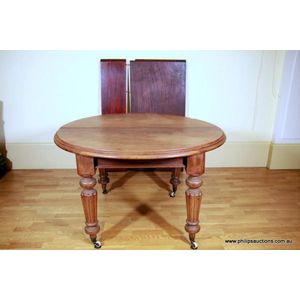
Victorian Cedar Extension Dining Table
A Victorian cedar extension dining table, second half 19th century; with two leaves, the circular table with thumb nail and bullnose edging above a skirt and block form capitals to turned and ribbed tapering legs terminating in toupie feet with brass caps…

1870s Cedar Extension Dining Table with 3 Leaves
Cedar extension dining table with 3 leaves, circa 1870s. 75 cm high, 118 cm wide, 160-295 cm long
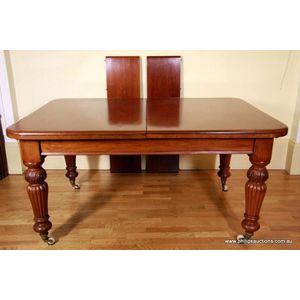
Victorian Cedar Dining Table with Extensions
A Victorian cedar extension dining table. second half 19th century, with two extension leaves and winder, the square table with rounded ends above a deep skirt with a reeded trim and supported on four waisted baluster reeded legs with foliate carved caps,…

Colonial Cedar Extension Banquet Table with Four Leaves
A 19th century Australian colonial cedar extension banquet table, rectangular form with four extra leaves, on bulbous turned legs. 74 cm high, 300 cm long, 132 cm wide

Australian Cedar Dining Set with Extra Leaves
An 19th century Australian cedar dining table with dining chairs and four extra leaves on turned fluted legs

Victorian Cedar Extension Table (222/150cm)
Victorian cedar extension table, 222 cm long (with 2 extension leaves), 150 cm long (with none), 127 cm wide, 75 cm high

Cedar D-End Extension Dining Table (Seats 10-12)
Colonial cedar D-end extension dining table on tulip carved legs (seats 10-12)

Antique Cedar Extension Table - 175cm x 122cm
Antique cedar extension table, 175 cm long (including 2 extension leaves 58 cm total), 122 cm wide, 76 cm high

Antique Cedar Dining Table with 3 Leaves and Winder
Antique round cedar extension dining table with three leaves and winder 209 cm x 122 cm x 76 cm high, becomes oval when fully extended

Antique Cedar Dining Table with Extension and Winder
An antique cedar two leaf extension dining room table seating 10 with winder.

Cedar D-End Extension Dining Table from 19th Century
19th century cedar D-end extension dining table

Victorian Cedar Extension Table with 2 Leaf Extensions
Victorian cedar D ended extension table, with 2 extension leafs (1 shown in photo, the other with a slightly darker finish), 246 cm long, 126 cm wide, 71 cm high approx, with no extension leafs forms a round shaped table, 124 cm long, 126 cm wide

Victorian Cedar Dining Table with 3 Leaves
A Victorian cedar extension dining table. 19th century, of solid and substantial form, the top with a thumb nail and bullnose edge, having a deep skirt and supported upon cup and tapering baluster legs terminating in brass casters; having three additional…

1870 Australian Cedar Extension Dining Table
An Australian cedar extension dining table with three leaves, circa 1870, the rectangular top with rounded ends above a plain frieze, raised on bulbous turned legs with ceramic castors, 125 cm wide, x 125 cm deep, 76 cm high, 238 cm long extended

Cedar Extension Dining Table with Blackwood Legs (Seats 10)
19th century cedar extension dining table with blackwood turned legs, seats 10

Victorian Cedar Oval Dining Table with Turned Legs
A mid-Victorian Australian cedar extending dining table, 1860s/'70s, the oval top (with two spare leaves) with rounded corners and a moulded edge above a plain frieze, raised on turned legs with brass caps and castors. Height 76 cm length 208 cm…

Cedar Dining Table with Extension - Seats 12
19th century cedar two leaf extension dining table on turned legs with brass and ceramic casters, seats 12

 Loading more...
Loading more...